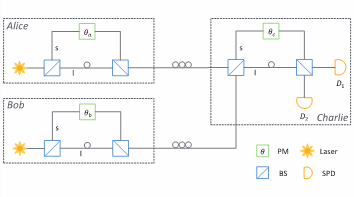Loading and transmitting information using photons, quantum key distribution can share random key among users with unconditional security. The security is ensured by the quantum nature of photons and independent with computational complexity where any eavesdropping can be detected and quantified. Quantum key distribution has attracted extensive attention, fiber-based quantum key distribution networks using BB84 protocol has been deployed on a large scale, it takes the first step along the roadmap of Quantum Internet.
The existing quantum key distribution networks are often based on trusted nodes, which requires that the relay nodes between users should be trusted and means a high requirement for the realistic security of networks. Therefore, the next step of Quantum Internet is to establish the quantum networks based on untrusted nodes where the measurement-device-independent network is an important puzzle of untrusted-node networks whose measurement node is untrusted naturally.
The measurement-device-independent networks are significantly different from the existing BB84 networks in system structure and coding. The development of measurement-device-independent networks requires the replacement of the existing network equipment, which means huge hardware cost and hinders the application of the next generation network. Therefore, to find a feasible evolution path is the key to promote the practical application of measurement-device-independent network.
The research group led by Prof. Zheng-Fu Han and Prof. Shuang Wang from the team of Prof. Guang-Can Guo in University of Science and Technology of China proposes a non-standalone networking scheme for quantum key distribution to explore an evolution path to measurement-device-independent networks. The research results are published in Photonics Research, Volume 9, No 10 (Guan-Jie Fan-Yuan, Feng-Yu Lu, Shuang Wang, et al. Measurement-device-independent quantum key distribution for nonstandalone networks[J]. Photonics Research, 2021, 9(10): 10001881).

Non-standalone networking scheme with two-protocol support
The scheme borrows the non-standalone evaluation form wireless networks whose key idea is to realize a smooth transition from the old network to the next generation network through the hybrid networking of old and new network protocols.
To realize the compatibility between the measurement-device-independent protocol and BB84 protocol in the same system, the research group redesigns the phase coding and projection measurement of the measurement-device-independent protocol. On the one hand, the requirement of time-bin encoding of measurement-device-independent protocol is removed. On the other hand, the same asymmetric interferometer as the BB84 protocol is introduced in measurement-device-independent protocol.
By so doing, the BB84 protocol can be performed. Furthermore, the research group find a low-error response mode by analyzing the detectors' responses of Bell states to realize the measurement-device-independent protocol. Finally, the hybrid networking of the two protocols is successfully realized with few hardware changes
The research group believes that the scheme can introduce the feature of untrusted nodes into existing networks with few cost, which supports the applications in the scenario with high security requirements. For the measurement-device-independent network, the scheme reduces the deployment threshold which would strongly promote its application.
The development of Quantum Internet faces many practical challenges. Although the roadmap mapped out the key stages of Quantum Internet, it still needs to provide a clear and feasible technical route for the leapfrog development between the stages.
In the future, the research group will continually pay attention to the practical application of Quantum Internet, and strives to promote the implementation of the next generation of quantum communication network.


